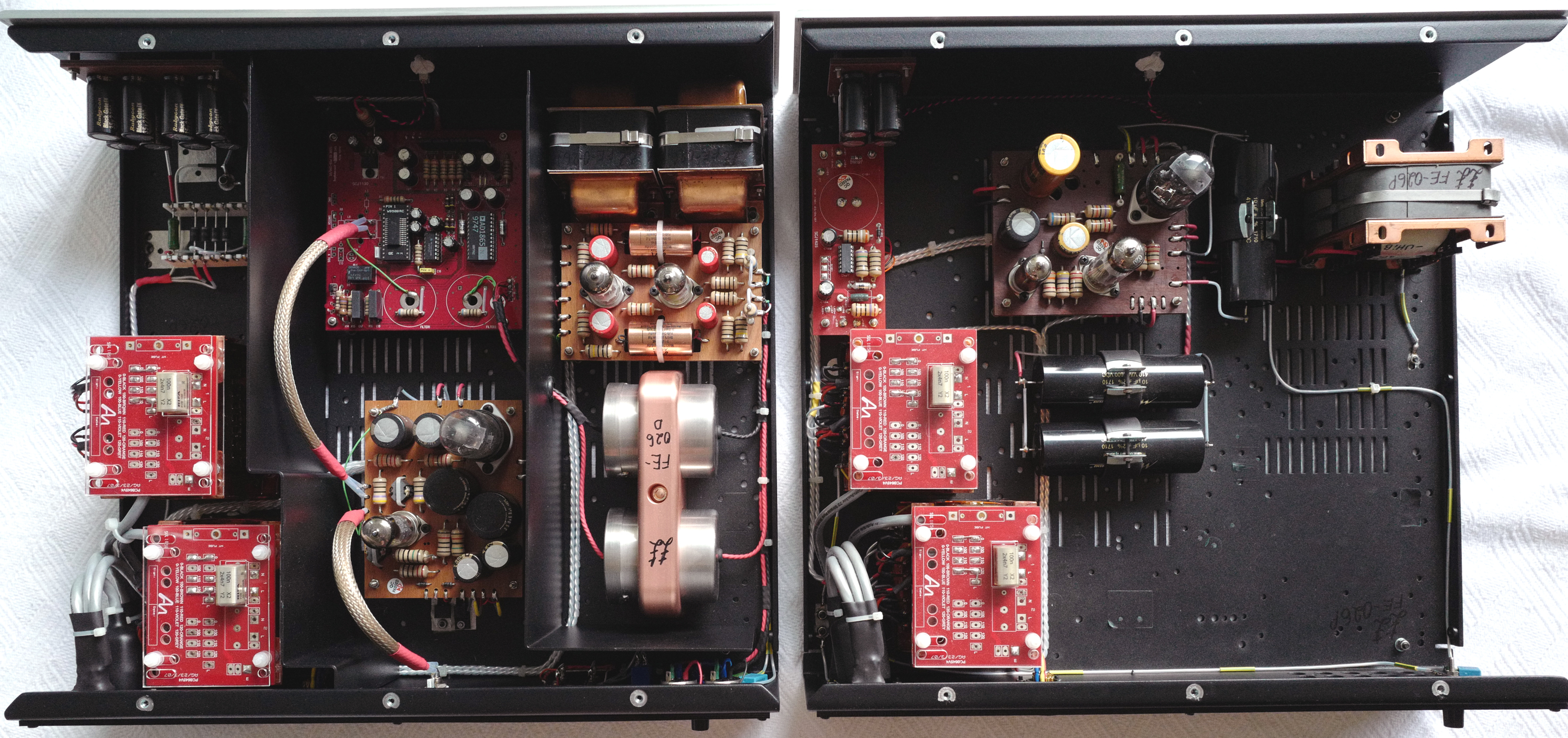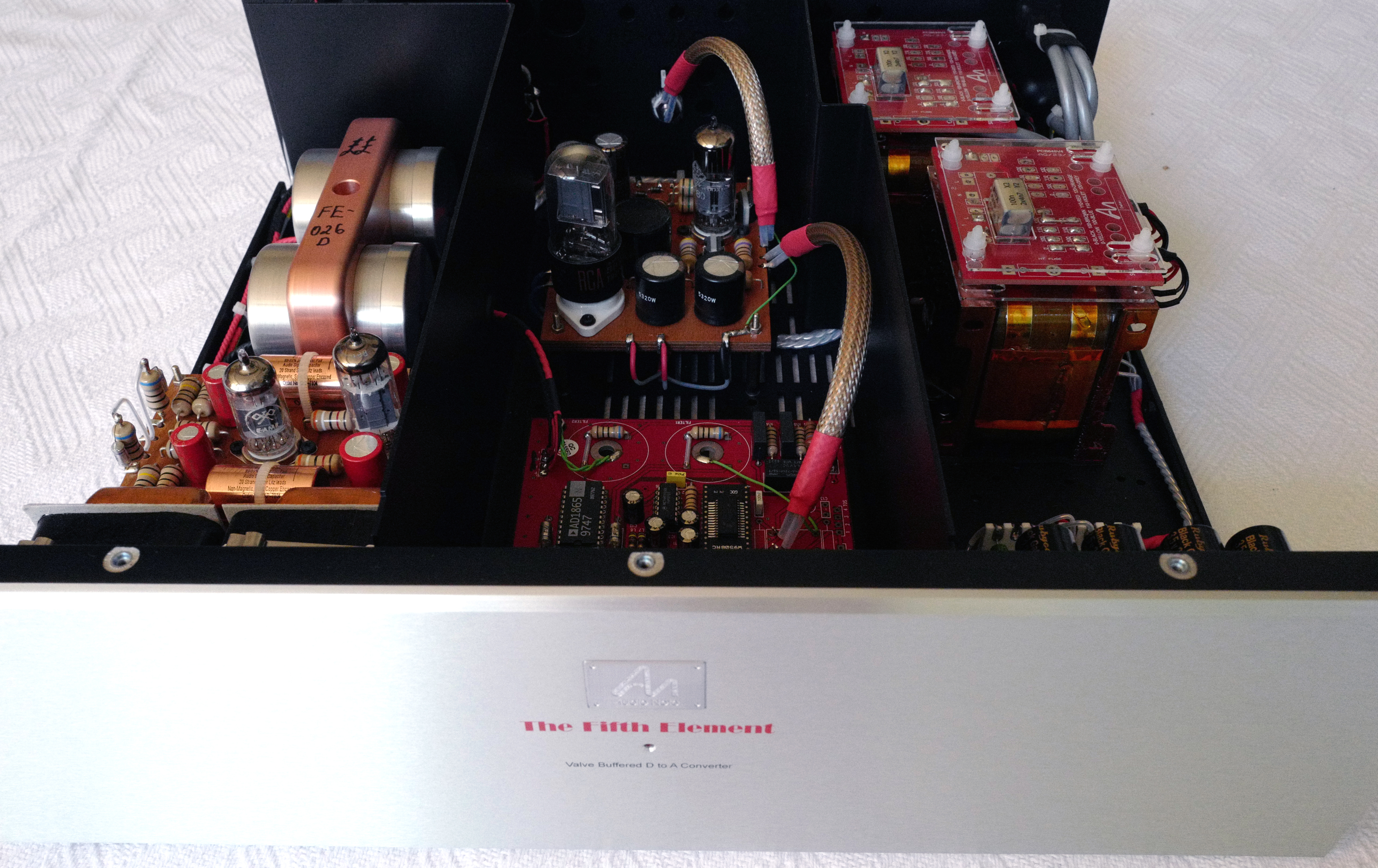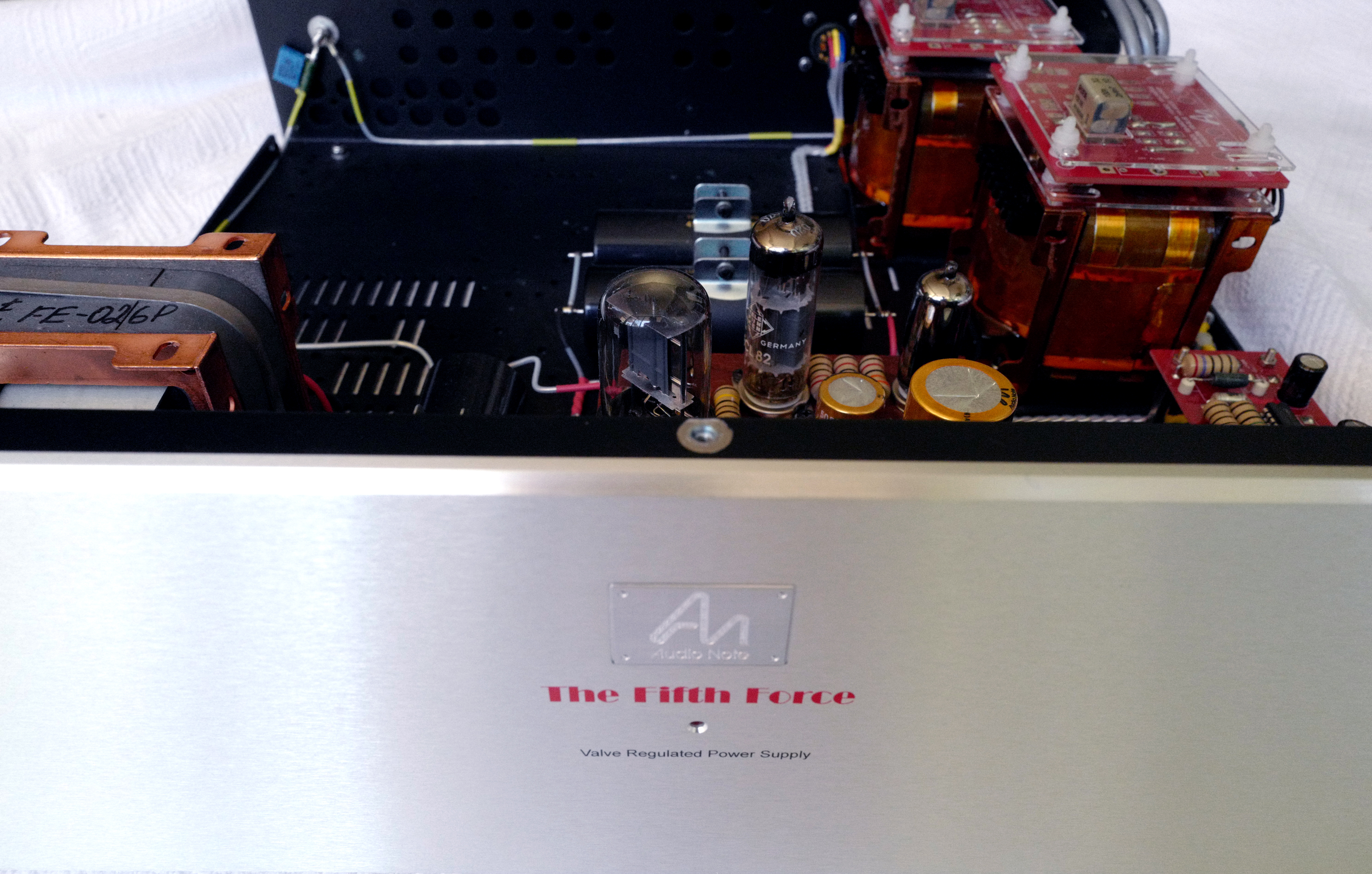Peter directs his company’s R&D efforts in highly ambitious and systematic approach. Accomplishments from the company’s continuing and notorious preamplifiers development process are introduced into the DACs gradually. For example, the aforementioned DAC 4.1x Balanced features an upgraded version of the output stage of the company’s M6 linestage ($17,350), utilizing 5814a and 6463 double triode valves, ANUK copper wired High B C-core output transformer, in addition to 80% nickel Super mu-metal cores for the filter-interface coils/transformers. The DAC5 Special, then, is additionally endowed with 99.99% pure AN silver wires for the coils/transformers cores. A higher “Signature” version exists for both DAC 4.1x Balanced and DAC 5 Special, which are equipped with more exotic and higher performing tubes and parts.
All ANUK DACs are digital products utilizing the most minimal amount of digital circuits and the least amount of digital processing with no digital filtering and oversampling scheme. Its approach epitomizes the furthest extent in how an analog product company does digital. Whereas chipsets endowed with the most powerful computational capability are employed in ANUK’s competitions’ DACs for the crucial task of digital filtering, the company turns to discrete components and acclimate those devices’ intrinsic properties to the task.
With the exception of the new Esoteric K-01XD, the Bricasti Design M21 and M1 thus far, the solid-states DACs that I auditioned throughout the years exhibited mechanical midrange through top-ends to varying degrees. A few tube DACs fared better, though also sounding homogenous and undistinguishing to certain extents, glossing everything over overly rosily. Too often manufacturers employ tube circuits to soften the sound to the detriment of character and individuality. And they can’t compete in the bottom-end definition category. I obtained mitigated results using A.R.T. Super SE power cables in conjunction with the $10,000, 96-pound PS Audio DirectStream Power Plant 20 AC regenerator. The results were emerging character and higher performance from the DACs in the form of more open top-ends, clearer and better defined midrange and more solid bottom-ends. But the inherent limitations persisted. The Fifth Element, however, was different.
For the Audio Note Fifth Element came with the Fifth Force power supply, and its version of the Galahad Power Supply didn’t seem to benefit from additional power conditioning, whether it was treated by the $2,800 Audio Reference Technology Power Distributor, or the colossal PS Audio AC regenerator.
The FEFF was revealing of transport caliber. While the Oppo UDP-205 sounded very impressive, the FEFF relayed far richer tonal sophistication and spatial cues from either of the two Esoteric SACD players.
As opposed to experiencing the sound the Audio Note UK way via a pair of flagship AN-E with AlNiCo tweeter, AlNiCo Hemp cone woofer, external crossover with heavily silver laden components, the FEFF was auditioned via the Esoteric K-03 SACD player, and later the K-01XD and then the Aurender N100SC server/streamer. The $42K pair of Pass Laboratories XA200.8 pure Class A solid-state monoblocks drove the $25,000 pair of Sound Labs Majestic 645 electrostatic panels, alternating with a $32K pair of the Bricasti Design flagship, M28 Class AB solid-state monoblocks. The Pass Labs Xs Preamplifier articulated the FEFF’s signals with exquisite gain. While wisdom has it the FEFF should’ve been reviewed in a pure tube system, the virtue of having it reviewed in an all solid-state system is the contrast of what one single tube component would bring to a high-purity solid-state system.
To describe the Audio Note UK Fifth Element/Fifth Force DAC’s sound is to illuminate the expertise harnessed by Peter and his team in scouting for the most exotic and tonally resplendent vacuum tubes ever in existence, complimenting and fortifying the tubes with a power supply of quality and level beyond what his contemporaries have attempted. As opposed to other DACs I have auditioned that focus on retrieving every bit of data, the Audio Note displayed layers of tonality.
The sound of the Audio Note UK Fifth Element/Fifth Force is pure and golden. As such, the pure and pristine tone of instruments, redbook or high-res, was stunning. Playing the James Galway Plays Khachaturian CD, the otherwise out-of-breath sounding flutist now had a change of breathing routine seemingly through the Audio Note. Amidst a more pronounced and spacious soundstage, now there is clearer airflow and tonal complexities in his playing, culminating in a very satisfying, fuller sounding flute.
But the FEFF didn’t behave like a typical piece of tube equipment. Contrasting the tube DACs that I auditioned that use tubes to soften the digital bite by glossing the entire spectrum over with tube pleasantries, the Fifth Element dramatized the midrange instead and infused it with spectacular variances of tone. Take the JVC XRCD2 Best Audiophile Voices VII, for instance, a most sensitively compiled collection of beautiful voices recorded sonorously which the Fifth Element illuminated with delicious display of beauty of tone that lingers in one’s mind. The difference between songs in mixing and ambience notwithstanding, the alluring playfulness of the female vocalists was made livelier, sweeter but never homogenous. The FEFF’s power of tonal differentiation was the most spectacular I’ve experienced, and a testament to the excellence of the XRCD.
Playback of 24/96 high resolution music downloads by the Aurender N100SC server/streamer from the likes of HDtracks, Presto Classical and Acoustic Sounds provided additional insights into the nature of the FEFF. Top audiophile picks such as the Proprius Cantate Domino, The King soundtrack, Jurassic Park soundtrack, some of which are digital files available in DSD, but also 24/96 or lower in resolution, highlighted the critical role of engineering in the recording and mastering of the music. The tone of instruments by the FEFF was the most spectacular, warranting multiple listening not only to savor the sheer beauty of sound but also to impart a deeper memory of the occasion for the moments away from the DAC.
The Deutsche Grammophon re-released high-resolution files of classical recordings of the sixties and seventies were given the second life via the Audio Note. Available through the HDtrack and Presto Classical websites, the 24/96 Beethoven 9 Symphonies by Karajan and the Berlin Philharmonic from the 1970s is a musical adventure that grows with you. The towering artistry of the conductor combined with the musicianship of the orchestra members produced a musical documentary riveting in such emotional depths and musical perfection that each listening brings new introspective and joy. Case in point being the Second Movement of the Third Symphony, “Eroica.” (or Heroic.)
The Second Movement, dubbed “funeral March,” is a traditional segment in a symphony of Beethoven’s time. Countless conductors delivered their otherwise capable musicians into eternal testaments of the abyss of ruin performing it, and quite a few notable others contorted the members of great orchestras to prove none other fact but the very egotistical and fragile temperamental nature of the conductors themselves.
But listen to Karajan’s recording of the movement and you’ll sense the might of the orchestra as completely and thoroughly brought out by him, sans temperamental flare ups and intrusions of ruinous “inspirations.” The Fifth Element/Fifth Force was the first DAC to energize and vitalize the surge of potent musical energy into a living thing that coursed through my veins. The result is a Beethoven funeral march so consciousness bending that takes up the entire domain of one’s brain, a sound that could almost occupy the human mind in a moment that seemingly can last an eternity. Now I will always find myself in that moment even with other DACs.
Each of Audio Note UK’s higher model incorporates such quantity of quality parts and components the likes of which the industry has never seen outside of AN UK products. Rome was not built in a single day; it took Peter and his team a lifetime of unrelenting research and procurement to fashion the inventory that enable the creation of products.
Owning an Audio Note UK product such as the Fifth Element/Fifth Force DAC is so much more than just experiencing a sound not obtainable in the rest of the audio industry, it is also about being part of a listener circle that continuingly experiences one of the most value- and performance-driven machines made for music as best can be.
This DAC is just a taste of things to come, and it is more for the folks who already have a whole suite of AN UK top gear, including the $150k AN-E speakers, the $100k Kegon Balanced monoblocks, the $100k M10 preamplification system, etc. The next owner of a Fifth Element/Fifth Force will likely be the kind of audiophiles to pick up a $23k Esoteric SACD player on his way home just to be able to play everything, in his new $200k Jaguar right from the dealership.
This is arguably the highest performance anyone can get out of a 24/96 DAC. It does not surpass modern DACs with the latest chipsets in dimensionality and sheer resolution, neither is it useful in decoding any of the higher resolution files. But one shouldn’t own a Bentley if the purchase decision is a difficult one. And if one has to consider the upkeep costs of a Ferrari, then he/she is not in the ideal position to buy one. Each one of us has our own priorities. What is an easy choice for one to purchase a $2,000 DAC may be the opposite to the next person. Do not fault the fellow who can afford a $153,000 DAC, just as others shouldn’t fault you for your extravagant purchases. Everything is relative and it is your money.
The FEFF hastens the demise of a reviewer’s career. It is not a product meant for him/her. For he could no sooner afford it than in danger of realizing the reviewing of other DACs is becoming mere curiosities and moot point. But if you can afford an A.R.T., an Aurender, an Esoteric, a couple of Pass Labs’, a Sound Lab and has lots of classical CDs, then the world is an oyster.
When one buys an Audio Note UK product, he/she is giving Peter Qvortrup and company the financial support it needs to continue its incursions into amassing the most ambitious and expansive NOS tubes sourcing and advanced engineering R&D known to the industry. Now, maybe Daniel Qvortrup can convince his father to investigate the AKM-based digital architecture…
Today is the man’s 70th birthday. A celebration is in order!
With special thanks to Audio Federation for the review loan.
- ← Previous page
- (Page 2 of 2)





A good review but the price is beyond ridiculous….
Try to review more affordable gear as not many have 153k to spend on DAC.
The price *is* beyond ridiculous. Still, I appreciate that you were able to acquire it for review. I find unobtainium fascinating. Thank you.
Fascinating review Thanks… Audio Note UK definitely charting their own path! Likely they will influence many creative minds moving forward due to their ability to sell extreme gear! Looking at their amps hardly inspires but for the beautiful fact that they are obviously well built and understated with form following function. Kondo has influenced Qvortrup and many others with his single ended triode amps with select materials (silver). I have some E speakers I dearly love influenced by the Snells. I am shocked by Peter’s courage to stick to this ole dac chip from 1999 and applaud his ability to sell 150,000 USD DACs based on it! I am building an ANKits 4.1 Dac and have an up sampling dac that is very detailed and able to decode higher bit rates and DSD. Audio Note’s focus on developing parts and interest in musicality above fad is inspiring. Someone buying this gear, can hand it down to their children, and with the replacement of some tubes and capacitors the gear will continue to sing. This smartphone I am tapping this comment on… in a few years will be obsolete… like much of the extreme computer gear now made, as this stuff can hardly be worker on. My hats off to the artists strutting their stuff at Audio Note Uk. Truly inspiring! DJS
The price may be rediculous BUT there is nothing comparable to it.
People at AN worked for years on it.
They dont sell huge amounts of these type of machines.
A Patek Philippe ( hope i got that name right ) is also rediculous when you compare it to a Swatch, but then again …..